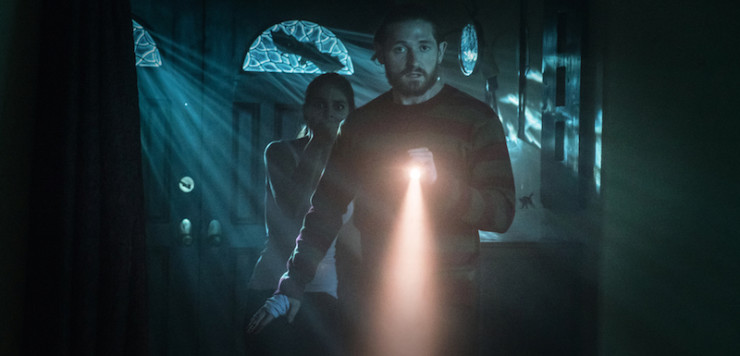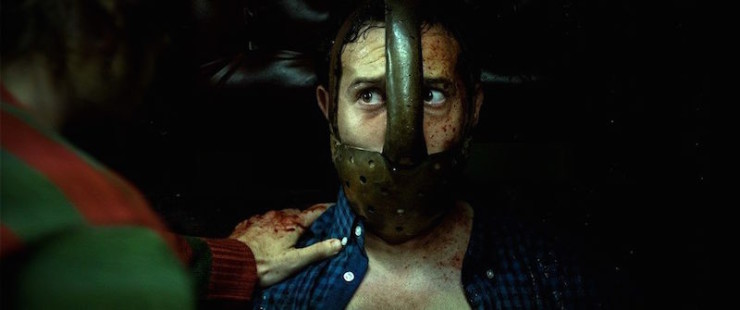When the incredibly self-referential The Cabin in the Woods thrilled audiences (in the physical and figurative senses) in 2012, it also brought with it an ominous message about the state of the horror genre: These guys control your world, and they are out to get you. Now, four years later, another movie is jockeying for the position of most meta commentary, from a new angle: Vincent Masciale’s Fear, Inc. explores what happens when you invite the scares upon yourself.
Traditional horror has run out of ways to scare us, Masciale (Funny Or Die) and screenwriter Luke Barnett assert through their unlikely protagonist, slacker dudebro (down to the man-bun) and horror junkie Joe (Lucas Neff): He can predict the jump scares in haunted houses, and he’s so burnt out on the genre that he looks for it in non-horror offerings, declaring that his favorite horror movie-style death scene is Game of Thrones‘ Red Wedding. “I want to cry like the last time I saw The Notebook,” he tells his long-suffering (and much more successful) girlfriend Lindsay (Caitlin Stasey). “I want to be destroyed. I want to shake in my boots.”
Enter Fear, Inc., a shady yet undeniably intriguing organization: They’ll tailor a horror-movie experience to your hopes, expectations, and (most importantly) fears.
Want to be stalked through a parking lot by a masked stranger ominously dragging his barb-wire-wrapped baseball bat along the ground? You got it. Prefer to have masked strangers lurk in every dark corner of your house sizing you up, The Strangers-style, before they strike? Fork over a couple grand, and the experience is yours. It’s the ultimate wish-fulfillment for the generation who pays handsomely for immersive theater like Sleep No More and arranges Escape the Room puzzles as teambuilding exercises.
Soon enough, Joe has roped Lindsay and their visiting couple friends, Ben (Chris Marquette) and Ashleigh (Stephanie Drake), into a live-action Saw/Friday the 13th/The Shining/Scream mashup. Those movies are just a few that get referenced, as Lindsay’s parents’ opulent Beverly Hills mansion is transformed into a haunted house of sorts, every room holding the potential to stage a reenactment of a famous horror movie death scene. This is where Joe becomes the heart of the movie: Once he realizes what’s going on, he is delighted. You have never seen someone so excited to face off against crazed murderers than this guy. Some of it is sheer stubbornness laced with some FOMO (fear of missing out): In an earlier scene, Ben tells Joe that he absolutely, under no circumstances should call Fear, Inc.: “My boss did it, and it’s horrible. You do not want to do it.” Well, we all know how the only reaction that kind of challenge provokes. But the moment Joe dialed that number, he became the hero and the consumer; his enjoyment is dependent on his own participation, and the narrative does not unspool without him. It’s both intense pressure and incredible freedom.
Joe (and the audience) is constantly faced with the dilemma of real or not real? As self-aware as its customers, Fear, Inc. the organization constantly changes its own internal logic, blurring the line between what exists as part of the game they’ve set up and what is not planned. Interestingly, these horror-movie scenarios bring to mind the kink pornography scene, in which adult performers discuss limits before the “scene” and debrief afterwards. But if there’s a safeword for Fear, Inc., it doesn’t seem to be communicated—because once this experience begins, there doesn’t seem to be a way to cancel it. (“Ma’am, you ordered this,” the customer service representative tells a terrified Abigail Breslin in her Drew-Barrymore-in-Scream opening-scene cameo.) Whenever the characters act like their circumstances are a game, they seem all the more real; in parts that are revealed to be real, they seem more like a game.
The movie is strongest when it interrogates the power of suggestion, how people react when they think that something is just a harmless prank versus something more sinister and much more fatal. In one particularly gruesome sequence that hilariously name-checks Jigsaw himself, Joe must buy in to the unspeakable horror he is asked to commit—just like the Saw victims in countless similar scenarios. It highlights the fact that much of horror is a selfish, or at least self-preserving, endeavor: From the first victims fatally splitting up to the Final Girl(s), our heroes are only looking out for themselves. Joe tailors this Fear, Inc. experience to his tastes but doesn’t take anyone else’s feelings into consideration; he would rather let Lindsay sob in terror than cancel the whole thing. (Which, again, is impossible anyway.)
There are definitely sequences that stretch the limits of plausibility, with the plot more resembling a matryoshka doll with all of its nested twists-within-twists. I seem to be the only one who came out of this year’s Tribeca Film Festival actually enjoying Fear, Inc.; Variety called it “mediocre,” while Bloody Disgusting docked points for a movie about wanting to feel something failing to inspire that in its viewers. To be fair, there were few true scares—aside from a lurking-killer shot that puts The Strangers‘ masterful creepiness to shame—and its pop culture references are rated by quantity rather than quality. That said, I felt so gratified to see a movie made so clearly for a Millennial like myself: A movie where the ideal couple’s Halloween costume is Walter White (with appropriate facial hair for her) and Jesse Pinkman, where guys “ice” each other just as often as they jump out of the bushes, where one of the characters is an Uber driver.
So many movies seek to establish themselves as timeless, to not date themselves with specific (and often fleeting) pop culture references. The Cabin in the Woods has earned a permanent spot in the horror library because of its deconstruction of how we wind up playing the same tired tropes in increasingly dire circumstances. Fear, Inc. may only be remembered as long as the Red Wedding is, but it’s like the best kind of haunted house: Something that may not stick with you long after it’s over, but that enraptured you in the moment.
Natalie Zutter watched at least half of this movie peeking out from between her fingers. Debate horror and metafiction (or both!) with her on Twitter.











